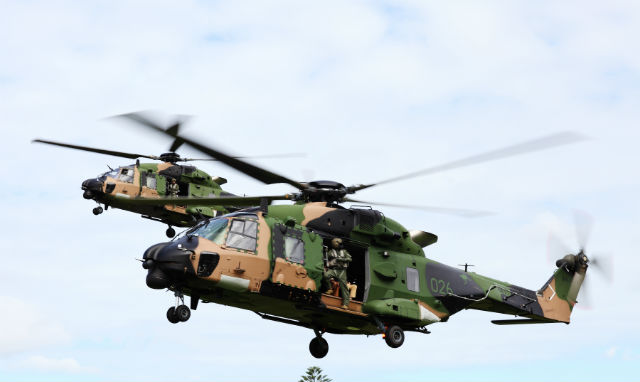In a scathing report, Australian auditors have blamed a series of procurement errors and “development deficiencies” for the delayed service entry of the nation’s fleet of NH Industries NH90 helicopters.
Final operational capability (FOC) for the rotorcraft is now not anticipated before April 2019 – almost five years late. In the meantime, the Australian Army Aviation Corps has had to continue operating its fleet of ageing Sikorsky S-70A Black Hawks beyond their planned retirement date.
The Royal Australian Navy has been left with a capability gap following the withdrawal from service of its Westland Sea King 50As in 2011.
Acquired under three separate phases of the Australian Defence Force’s (ADF) Project Air 9000 requirement – worth a projected A$4 billion ($3.8 billion) – an initial contract for 12 helicopters was signed in 2005, with a contract modification covering an additional 34 examples completed in 2006.
However, the Australian National Audit Office (ANAO) says in its report that defence chiefs initially recommended the purchase of 12 new-build Sikorksy S-70M Black Hawks, along with 36 new or remanufactured S-70Ms for the second phase.
This decision was overruled by the then Liberal-National coalition government led by John Howard, the ANAO says, despite being supported by most of the armed forces’ senior commanders.
Although the NH90 TTH variant selected – known as the MRH90 in Australian service – theoretically also matched Canberra’s needs, some nine years since the contract signing the 11t rotorcraft is still underperforming.
“Further, operational tests and evaluations had not validated the ability of the MRH90 to satisfy any of the 11 operational capability milestones set by the army and navy,” the ANAO says, blaming the relative immaturity of the programme when deliveries began in 2007.

Commonwealth of Australia
Redesigns have been required for some elements, including bolstered cabin floors and windscreens, rappelling hooks and door gunner positions, the ANAO adds. In addition, the provision of common spares has been found to be lacking, and sustainment has proven more costly than originally forecast.
"Overall, [the defence ministry] has had to cope with ongoing commercial and technological management issues which are yet to be fully resolved, with sustained improvements in MRH90 capability and value for money yet to be demonstrated," it adds.
The ANAO report highlights “development deficiencies and acquisition decisions” as the primary causes of the difficulties experienced by the programme.
Crucial stages of development were not appropriately performed, leading to “serious and potentially long-term consequences for capability delivery and expenditure”, the ANAO says.
With the acquisition of the MRH90, the fleet of S-70A Black Hawks operated by the Australian Army Aviation Corps since the 1980s was to have been withdrawn by December 2013. However, the retirement did not commence until January 2014, and is now not scheduled to be complete until June 2018.
FOC for the MRH90 was originally to be declared in July 2014, but this is now not expected to be realised until April 2019.
The ANAO does highlight some benefits from the programme, however, through the localisation of MRH90 assembly at the Brisbane facility of Airbus Helicopters’ subsidiary Australian Aerospace. All but three of the 28 helicopters delivered to date have been built at the site.
This capability has also spawned a dedicated composite component manufacturing capability, feeding into NHI’s global supply chain. However, the report does not quantify the value of this work.
Source: FlightGlobal.com



















